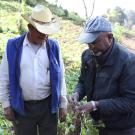Potato cyst nematodes are small roundworms (about the size of a pin head) that feed on the potato. The cyst nematodes cause potato plants to not grow well, reducing foliage and the tubers are smaller as well.When there are too many potato cyst nematodes in a field of potato plants, then the plants yield fewer and smaller potatoes.
In Guatemala, Brent Sipes of the University of Hawaii at Manoa is leading a research team that's working with smallholder potato farmers on integrated technologies for nematode and soil health management, with the goal that farmers achieve sustainable yields that provide income, food and nutritional security.
This presentation focuses on two aspects of the project:
- field experiments to manage potato cyst nematodes and improve soil health
- mental modeling of the farming community to improve extension activities
The project involves improving soil health to control plant parasitic nematodes. Healthy soil has a complex food web that is resilient to changes and suppresses pests and pathogens. Among the soil health management practices used by the project team are:
- Incorporation of organic matter – composted chicken litter.
- Application of biological control organisms.
The team measured potato yields and soil health indices for both Andisol and Mollisol soil types, across different levels of treatment with the biological control organisms and composted chicken litter.
Cognitive mapping links perceived interactions between agricultural practices, soil health, nematode numbers and potato yields. After the cognitive mapping and field experiments, the team recommended to farmers to incorporate organic matter and apply biological control organisms to bolster soil health and deter nematodes.
This presentation showcases illustrative photographs and figures detailing the cognitive mapping strategy and result.
This presentation was given by Brent Sipes of UH Manoa, as part of the Horticulture Innovation Lab's 2018 annual meeting in Kigali, Rwanda.

